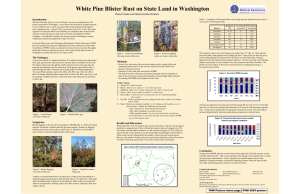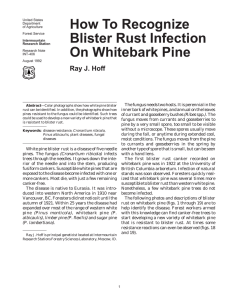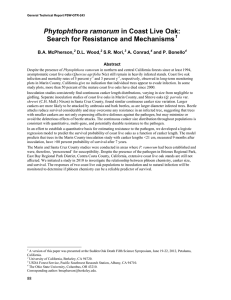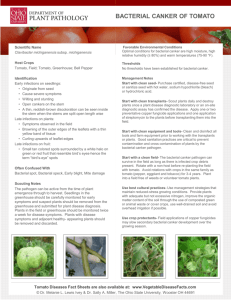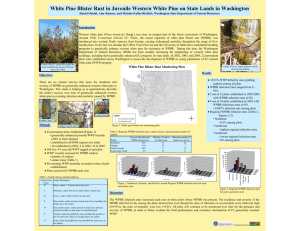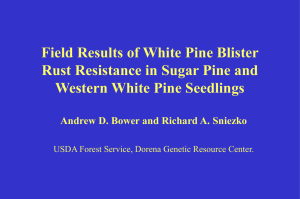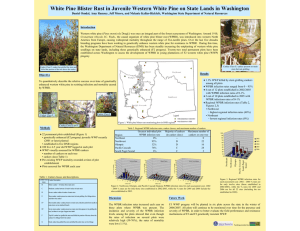For. Path. 39 (2009) 177–191 doi: 10.1111/j.1439-0329.2008.00575.x
advertisement
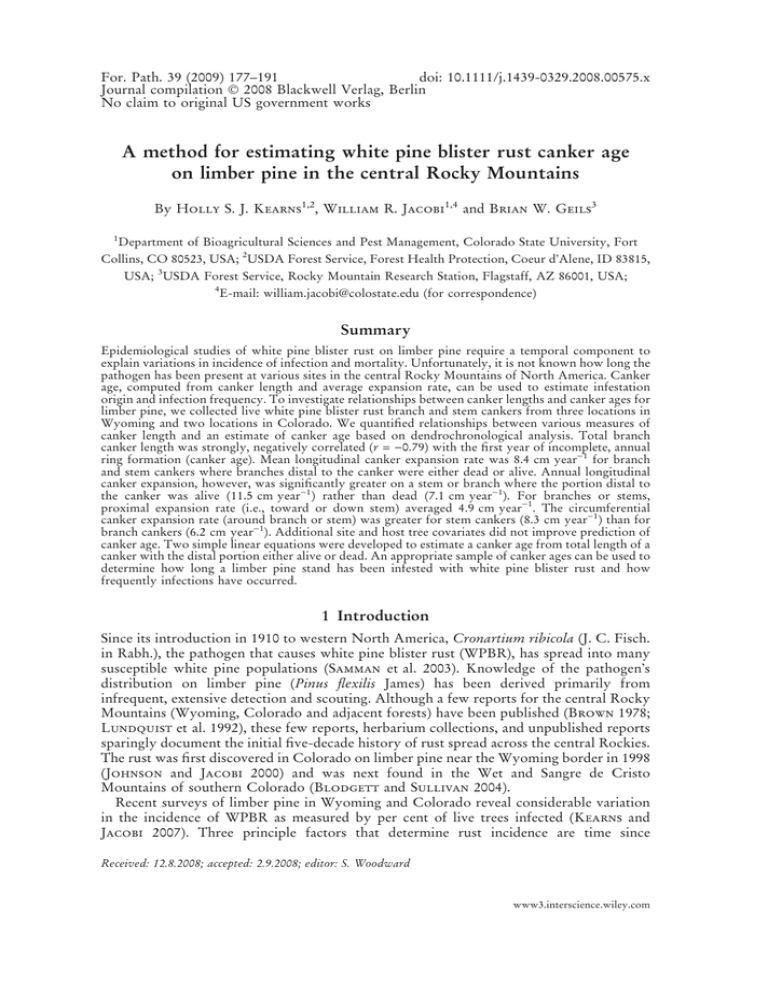
For. Path. 39 (2009) 177–191 doi: 10.1111/j.1439-0329.2008.00575.x Journal compilation 2008 Blackwell Verlag, Berlin No claim to original US government works A method for estimating white pine blister rust canker age on limber pine in the central Rocky Mountains By Holly S. J. Kearns1,2, William R. Jacobi1,4 and Brian W. Geils3 1 Department of Bioagricultural Sciences and Pest Management, Colorado State University, Fort Collins, CO 80523, USA; 2USDA Forest Service, Forest Health Protection, Coeur dÕAlene, ID 83815, USA; 3USDA Forest Service, Rocky Mountain Research Station, Flagstaff, AZ 86001, USA; 4 E-mail: william.jacobi@colostate.edu (for correspondence) Summary Epidemiological studies of white pine blister rust on limber pine require a temporal component to explain variations in incidence of infection and mortality. Unfortunately, it is not known how long the pathogen has been present at various sites in the central Rocky Mountains of North America. Canker age, computed from canker length and average expansion rate, can be used to estimate infestation origin and infection frequency. To investigate relationships between canker lengths and canker ages for limber pine, we collected live white pine blister rust branch and stem cankers from three locations in Wyoming and two locations in Colorado. We quantified relationships between various measures of canker length and an estimate of canker age based on dendrochronological analysis. Total branch canker length was strongly, negatively correlated (r = )0.79) with the first year of incomplete, annual ring formation (canker age). Mean longitudinal canker expansion rate was 8.4 cm year)1 for branch and stem cankers where branches distal to the canker were either dead or alive. Annual longitudinal canker expansion, however, was significantly greater on a stem or branch where the portion distal to the canker was alive (11.5 cm year)1) rather than dead (7.1 cm year)1). For branches or stems, proximal expansion rate (i.e., toward or down stem) averaged 4.9 cm year)1. The circumferential canker expansion rate (around branch or stem) was greater for stem cankers (8.3 cm year)1) than for branch cankers (6.2 cm year)1). Additional site and host tree covariates did not improve prediction of canker age. Two simple linear equations were developed to estimate a canker age from total length of a canker with the distal portion either alive or dead. An appropriate sample of canker ages can be used to determine how long a limber pine stand has been infested with white pine blister rust and how frequently infections have occurred. 1 Introduction Since its introduction in 1910 to western North America, Cronartium ribicola (J. C. Fisch. in Rabh.), the pathogen that causes white pine blister rust (WPBR), has spread into many susceptible white pine populations (Samman et al. 2003). Knowledge of the pathogenÕs distribution on limber pine (Pinus flexilis James) has been derived primarily from infrequent, extensive detection and scouting. Although a few reports for the central Rocky Mountains (Wyoming, Colorado and adjacent forests) have been published (Brown 1978; Lundquist et al. 1992), these few reports, herbarium collections, and unpublished reports sparingly document the initial five-decade history of rust spread across the central Rockies. The rust was first discovered in Colorado on limber pine near the Wyoming border in 1998 (Johnson and Jacobi 2000) and was next found in the Wet and Sangre de Cristo Mountains of southern Colorado (Blodgett and Sullivan 2004). Recent surveys of limber pine in Wyoming and Colorado reveal considerable variation in the incidence of WPBR as measured by per cent of live trees infected (Kearns and Jacobi 2007). Three principle factors that determine rust incidence are time since Received: 12.8.2008; accepted: 2.9.2008; editor: S. Woodward www3.interscience.wiley.com 178 Holly S. J. Kearns, William R. Jacobi and Brian W. Geils introduction, infection rate and canker loss due to host or branch mortality. Infection is influenced by inoculum abundance, microclimate and genetics (host resistance and pathogen virulence and aggressiveness). Infection and mortality vary from year to year and from stand to stand. Explaining the variation in incidence requires information on all three factors. Because infestations on limber pine often go undetected for decades, their approximate date of origin can only be estimated from the age of remaining intact cankers. Typically, estimates of canker age (and by extrapolation, year of infection) in white pines have been based on the age of the host shoot at the infection site (Lachmund 1933a,b). The progressive and characteristic development of a rust canker (Colley 1918; Ehrlich and Opie 1940; Hudgins et al. 2005) allows for identification of the infection site or canker origin as a needle on the longest-dead shoot segment. Because many white pine species display a distinctive, annual whorl of branches and evident bud-scale scars, it is normally possible to age the host shoot. As infection cannot occur before shoots are formed and is unlikely to occur after needle shed, an estimated canker age is restricted to be within a few years of the shoot age. If infection were predominantly on a single needle-age class, a probable year of infection could also be determined with a delay-adjustment term (Lachmund 1933a; Hirt 1944; Kimmey 1954). Although this ageing method for cankers has been applied to numerous pine species, confidence in estimates of canker age declines for white pine species such as limber pine where age of infected shoot is indiscernible because: (i) needles are commonly retained for up to 10 years (Schoettle and Rochelle 2000); (ii) the susceptibility of needle age-cohorts is unknown; and (iii) infections commonly enter older, main branches from foliated, short, side branches. An alternative approach is to try to estimate canker age from canker lengths and their rate of expansion. Numerous researchers have examined canker expansion in white pine species other than limber pine (Rhoads 1920; Lachmund 1934; Slipp 1951; Harvey 1967; Phelps and Weber 1969). These white pines include western white pine (Pinus monticola Dougl. ex D. Don.), sugar pine (P. lambertiana Dougl.), and eastern white pine (P. strobus L). The factors identified to have an affect on canker expansion rate are: host species, growing site, length of growing season, branch diameter, canker age and condition of shoots distal to cankers. Canker expansion rates are determined either from the observed increase in length over a monitored period or from a length accrued as the pathogen first invaded the shoot. Each method presents different challenges. Although monitoring cankers appears simple, repeat observations over a period of years are needed. Measuring canker lengths on a random sample of cankers is simple, but determining the expansion period demands an understanding of pathogenesis, histology, biotic interactions and dendrochronology. The parasitism of Cronartium ribicola and its histology in white pine are well described – early by Colley (1918) and Rhoads (1920), later by Krebill (1968), and recently by Hudgins et al. (2005). Key and relevant observations are the growth and distribution of rust hyphae; reactions of cambium, phloem and xylem; production of phenolic compounds; and cambial death after the stem cortex is ruptured during spore production. Canker development is often accompanied by parasitism by other fungi (e.g., Wicker and Woo 1973) and feeding by various insects (Furniss et al. 1972). An expected course of disease development begins with infection through a needle, hyphal growth into the stem, spermatia production, aeciospore production and discharge (Lachmund 1933b). Localized cambial death follows after the cortex is ruptured by processes of sporulation, secondary insect and fungus attack and desiccation. Although the elapsed time from infection to cambial death (latency) can not be more precisely determined than one to several years, cross-dating xylem rings by dendrochronology does provide a precise and accurate date of the last or partial ring formation. This date can then be used as the year when the canker began visible expansion on a branch or stem, one to several years after infection initiation on a needle. Method for estimating white pine blister rust canker age on limber pine 179 An understanding of the epidemiological history of WPBR on limber pine in the central Rockies is necessary for assessing its potential spread and impact. Currently, there is insufficient information specific to limber pine to provide an adequate method for ageing cankers that would be useful for reconstructing histories of rust introduction and intensification on this species. Given the difficulty and uncertainty of determining canker age from shoot age in the blister rust – limber pine pathosystem, in this study we proposed to investigate the use of canker length and expansion rate to estimate canker age. Our objectives were to: (i) quantify rates of canker expansion and age by using dendrochronology; (ii) assess site, stand and tree covariates for predicting canker age from canker length; and (iii) describe a field-practical procedure for estimating canker age from a canker length and respective expansion rate. 2 Materials and methods 2.1 Canker collection From April to September 2003 we collected 134 living stem (22) and branch (112) cankers from 70 limber pines within 19 collection sites located in five study areas: Shirley Mountains, Muddy Mountain and Pole Mountain, Wyoming; and the Roosevelt and San Isabel National Forests, Colorado (Fig. 1). Elevations of collection sites ranged from 2290 to 2895 m. These study areas were selected as they were behind the leading edge of the epidemic (Kearns and Jacobi 2007) and apparently infested in the last 10–25 years, such that cankers originated from a variety of infection years. Cankers chosen were those with live cambium proximal to a canker and showing evidence of recent expansion and ⁄ or sporulation. Branches were cut at the branch collar and cankered stems were cut 60–90 cm below the canker margin. For each sampled tree the following data were recorded: diameter class (£ 5, 5.1–15.4, 15.5–30.5, or ‡30.6 cm diameter at breast height [DBH] of 1.37 m), crown class, percent live crown, height and other damages present. For each canker, the type (branch or stem), distance to bole, branch height and canker origin height were recorded. At each collection site, the elevation, geographic coordinates, slope percent, slope aspect, slope position, slope configuration, stand structure and the three most common overstory and understory cover plants were recorded. 2.2 Canker measurements Cankers were visually assessed and measured in the lab. Total canker length (extent of the zone of bark discolouration), branch or stem diameter at canker origin, diameter of the branch or stem below the canker (proximal diameter), proximal and distal canker lengths (as measured from canker origin) were recorded (Fig. 2). The leading edge of the fungal hyphae was assumed to be <1 cm beyond visible bark discolouration (Krebill 1968). The putative canker origin or initiation site was determined to be where bark cracking, swelling and other symptoms indicated the oldest affected area on the branch or stem (Ôcanker centerÕ of older literature). Cross-sections were made through canker origins and through unaffected tissue at the base of the branches or stems to provide a baseline for tree ring comparisons. Cross-sections were sanded and examined using a binocular microscope. Cross-dating using the skeleton plot technique (Stokes and Smiley 1968; Swetnam et al. 1985), a graphical technique for comparing ring-widths, was utilized to determine the year the first incomplete ring formed at the canker origin; i.e. Ôfirst year of cambial death on a shootÕ (Fig. 3). Master chronologies were developed from the live, unaffected crosssections obtained from the base of every cankered branch or stem at each collection site and served as the basis for cross-dating cross-sections at the canker origin. The number of partial or incomplete rings formed at the canker origin and the year in which an orange 180 Holly S. J. Kearns, William R. Jacobi and Brian W. Geils Fig. 1. White pine blister rust canker collection areas in Wyoming and Colorado. stain (a possible indication of host response to infection) was first evident in an annual ring were recorded. The presence on cankers of twig beetles, wood borers, apothecia, pycnidia, perithecia and fungal stain in the xylem rays was also recorded, but no attempt was made to isolate and culture fungi. Method for estimating white pine blister rust canker age on limber pine 181 Fig. 2. A white pine blister rust branch canker on limber pine showing proximal and distal branch sections relative to the canker centre ⁄ origin. Fig. 3. Cross-section through a white pine blister rust canker on limber pine, showing the entire canker disc with two partial rings formed beyond the first cambial mortality and the orange stain which in this sample appeared 2 years before the last complete ring. 2.3 Data analyses All statistical analyses were performed using the statistical program sas (version 9.1, SAS Institute Inc., Cary, NC, USA). Analysis of variance in number of years since cambial death at canker origin was run with a mixed linear model permitting correlation and non-constant variability (PROC MIXED); this procedure used study area and tree (from which cankers were collected) as random effects. The mixed linear model procedure (study area and tree as random effects) was also used to develop multivariate expansion rate models. Type three tests of fixed effects were calculated for each of the model variables to determine their significance. Parameter estimates and differences among the parameter estimates based on the Tukey–Kramer adjustment for multiple comparisons were generated. Previous studies have reported that approximately 80% of annual canker expansion in western white and sugar pine occurs during the growing season (May–October) of the host 182 Holly S. J. Kearns, William R. Jacobi and Brian W. Geils and 20% occurs during the winter (Kimmey 1940; Slipp 1951). To account for the amount of the cankerÕs last year of expansion that could have occurred prior to it being collected by us, measurements were adjusted according to the date of collection. Cankers collected before May 15 were assumed to have attained 20% of the total yearÕs expansion. Similarly, cankers collected May 16–June 15 were assumed to have attained 36% (20% + 1 ⁄ 5 * 80%), June 16–July 15 to have attained 52%, July 16–August 15 to have attained 68%, and August 16–September 30 to have attained 84% of the yearÕs expansion. Number of years that the cambium was dead at the canker origin was determined by subtracting the year of the last complete ring formation from the time that the canker was collected. Maximum longitudinal canker expansion rate was then calculated as the total canker length divided by the number of years dead (years since the first section of cambium was killed). This rate was considered a maximum potential rate because the progression from visible, external symptoms of cankers to cambial death would take a minimum of 1 year and possibly considerably longer. In western white pine, the time between needle infection and the appearance of orange bark coloration, indicating infected tissue, ranged between 10 and 41 months (Lachmund 1933b). Following this incubation period, the production of spermatia takes another 1 to 10 months. Then, after another 6 to 30 months aeciospores are produced in the area that previously produced spermatia (Lachmund 1933b). It is the production of these aeciospores that disrupts the bark and likely causes or is related to the time of cambial death that results in incomplete ring formation (Colley 1918; Krebill 1968). We assumed that the minimum length of time between the first appearance of the canker (orange bark coloration) and disruption of the cambium was 12 months for all samples. For example, bark infection visible during the summer would result in pycnia production in the fall, and aecia production the following spring and cambial disruption occurring shortly thereafter. Twelve months represents a minimum period of time between external evidence of a canker and disruption of the cambium, as it could be considerably longer and is yet to be determined for limber pine. The proximal canker expansion rate was calculated as the proximal canker length, or distance from canker origin to the proximal edge of external canker symptoms, divided by the number of years dead. Circumferential expansion rate was calculated by dividing the circumference of the branch or stem at the canker origin by the number of partial rings formed at the canker origin. T-tests were utilized to determine if the presence of any of the insects or fungi were related to total canker length, diameter at canker origin, years dead at canker origin, and branch height. Mantel-Haenszel Chi-square analysis was used to determine if the presence of insects or stain fungi was affected by the distal branch segment being dead or alive, with an adjusted p < 0.05. 3 Results 3.1 Canker length The mean total length of the 134 cankers was 37.1 cm (2.1 standard error (SE), range 6.0– 123.0 cm). Branch cankers ranged in length from 6.0 to 109.0 cm with a mean of 34.7 cm (2.0 SE), and stem cankers ranged in length from 14.0 to 123.0 cm with a mean of 48.7 cm (7.0 SE). Mean branch or stem diameter at the proximal end of the canker, taken at the outer edge of the canker beyond any swelling caused by C. ribicola infection, was 3.3 cm (0.2 SE) and ranged from 0.1 to 15.2 cm. Branch cankers had a mean proximal diameter of 3.0 cm (0.1 SE, 0.1–9.9 cm), and the mean proximal diameter of stem cankers was 5.0 cm (0.7 SE, range 1.4–15.2 cm). The height above the ground of the canker at canker origin was 2.6 m (0.1 SE, range 0.2–4.5 m) for branch cankers and 2.0 m (0.2 SE, range 0.5–3.7 m) for stem cankers. The trees from which cankers were collected were 5.0 m tall (0.2 SE, range 1–11 m) and 82% were between 5.1 and 30.5 cm in diameter. Method for estimating white pine blister rust canker age on limber pine 183 Total canker length, whether the canker was located on a branch or stem, was strongly and negatively correlated with the first year in which an incomplete ring was formed at the canker origin (Table 1). The total canker length was positively correlated with the number of years that the cambium was dead in a particular location of the circumference and number of partial rings formed at the canker origin (Table 1). Total canker length was also positively correlated with proximal branch ⁄ stem diameter, diameter at the canker origin, and canker origin height. The correlation between canker length and tree height was positive and stronger for stem cankers than for branch cankers. Total branch canker length was not correlated with distance to the bole, branch height, or percent live crown. Proximal canker length, whether the canker was located on a branch or stem, was negatively correlated with the first year in which an incomplete ring was formed at the canker origin, and positively correlated with the number of years since cambial death (years dead), proximal branch ⁄ stem diameter, and diameter at canker origin (Table 1). Proximal branch canker length was not correlated with distance to the bole or branch height. Proximal stem canker length was positively correlated with tree height, but no significant tree height relationship was found with proximal branch canker length. An orange stain that appears to be a resin-like deposit (Fig. 3) was present in the annual rings of 85% (95) of the branch cankers and 86% (19) of the stem cankers analysed. In all but one cankered cross-section, the orange deposits were located at the beginning of the annual ring. The first year in which this orange deposit was visible within the annual rings at the canker origin was strongly and negatively correlated with total and proximal canker length for both stem and branch cankers (Table 1). The orange deposits appeared an average of 1.75 (0.12 SE) years before the first incomplete ring was formed at the canker origin for all cankers, and ranged from 1 to 5 years. For branch cankers, the orange deposit was evident an average of 1.56 (SE 0.13) years before the first incomplete ring was formed at the canker origin, while for stem cankers it was an average of 2.68 (SE 0.28) years. Analysis of variance indicated that the number of years since cambial death at the canker origin was significantly greater for cankers with the distal portion dead at the time of examination (p < 0.0001) and increased with total canker length, and that the effect of Table 1. Pearson correlation coefficients for total and proximal canker lengths of white pine blister rust branch and stem cankers collected from limber pines in southeastern Wyoming and Colorado in 2003. Total canker length Branch cankers First year incomplete Years dead Partial rings Orange deposit Proximal diameter Canker origin diameter Canker origin height Tree height Per cent live crown Distance to bole Branch height 1 Proximal canker length Stem cankers n r p > r1 n 112 112 112 95 111 112 97 110 110 87 94 )0.79 0.80 0.45 )0.78 0.75 0.72 0.21 0.23 )0.09 0.07 )0.04 **** **** **** **** **** **** * * ns ns ns 22 )0.67 *** 22 0.67 *** 22 0.52 * 19 )0.85 **** 22 0.80 **** 22 0.64 ** 22 0.53 ** 22 0.68 *** 22 )0.47 * r p > r1 Branch cankers Stem cankers r p > r1 r p > r1 )0.78 0.78 0.40 )0.79 0.70 0.65 0.21 0.15 )0.03 0.03 )0.03 **** **** **** **** **** **** * ns ns ns ns )0.74 0.74 0.42 )0.80 0.83 0.51 0.44 0.67 )0.38 **** **** ns **** **** * * *** ns Level of significance ****p < 0.0001, ***p < 0.001, **p < 0.01, *p < 0.05, ns p ‡ 0.05. Holly S. J. Kearns, William R. Jacobi and Brian W. Geils 184 Table 2. Results and parameter estimates for the model describing number of years since the death of part of the cambium at the canker origin, or canker age, for white pine blister rust cankers in limber pine based on the condition of the branch or stem distal to the canker. Type 3 tests of fixed effects Numerator Denominator F-value DF1 DF1 Effect Total length Distal condition Alive distal Dead distal 1 1 2 8 74 Solution for fixed effects p>F 33.88 0.0004 38.62 <0.0001 Estimate Standard Error t-value p>t 0.074 0.013 5.82 0.0004 0.943 3.097 0.418 0.353 2.26 8.77 0.027 <0.0001 Degrees of freedom, n = 134. canker type as stem or branch was not significant. Therefore, regardless whether the canker is on a branch or stem (Table 2), the number of years since the death of part of the cambium at the canker origin – canker age (ca) – can be estimated from total canker length, cm (tcl) for cankers: where the distal portion is alive ca ¼ 0:943 þ 0:074 tcl or, where the distal portion is dead ca ¼ 3:097 þ 0:074 tcl: 3.2 Longitudinal canker expansion rate Longitudinal canker expansion rate, total canker length divided by canker age, ranged from 2.2 to 27.2 cm year)1 and averaged 8.4 cm year)1 (0.4 SE) for all cankers (Table 3). Stem cankers had a mean expansion rate of 10.5 cm year)1 (0.9 SE) compared with the average expansion rate of 8.0 cm year)1 (0.4 SE) for branch cankers. Although there was a trend of increasing expansion rate with increasing proximal diameter (Table 3), differences between diameter classes were not significant. Branch canker expansion rate was positively correlated with branch diameter at the canker origin (r = 0.32, p < 0.001), but there was no correlation between stem canker expansion rate and either canker origin or proximal diameter. Neither branch nor stem canker expansion rate were related to tree diameter class, height, health status, crown class, per cent live crown, the cankerÕs distance from the bole, or the height of the canker. Table 3. Mean longitudinal canker expansion rates for white pine blister rust cankers in limber pine based on the condition of the branch or stem distal to the canker. All cankers Proximal diameter (cm) 0.1–1.7 1.8–2.4 2.5–3.1 3.2–4.4 ‡4.5 Total Distal portion alive n Mean total expansion (cm year)1) SE 1.27 1.16 1.18 1.29 1.17 12 14 14 5 5 8.84 8.91 11.47 16.26 11.79 0.37 50 11.46 n Mean total expansion (cm year)1) SE 24 28 26 27 29 7.15 7.70 8.67 11.96 10.95 134 8.42 Distal portion dead n Mean total expansion (cm year)1) SE 1.39 1.38 1.41 2.13 1.82 12 14 12 22 24 5.45 6.50 5.88 7.66 10.11 1.90 1.63 1.58 1.47 1.22 0.87 84 7.12 0.95 Method for estimating white pine blister rust canker age on limber pine 185 Analysis of variance suggested that the effect of canker type, stem or branch, was not significant (p = 0.716); branch and stem cankers were therefore pooled in further analyses. There was, however, significantly greater (p < 0.001) mean annual expansion for cankers with distal sections alive than distal sections dead (Table 3). For those stems ⁄ branches on which the portion distal to the canker remained alive (continuous expansion in two directions), the mean longitudinal expansion rate was 11.5 cm year)1 (0.9 SE). For those stems ⁄ branches on which the portion distal to the canker had died (proximal expansion continuous but distal expansion discontinued after several years), the mean longitudinal expansion rate was 7.1 cm year)1 (0.9 SE). 3.3 Proximal canker expansion rate Proximal expansion rate, a measure of annual expansion toward the stem for branch cankers and down the stem for stem cankers, ranged from 0.1 to 13.1 cm year)1 and averaged 4.9 cm year)1 (0.2 SE) for all cankers. The proximal expansion rate was positively but weakly correlated with branch ⁄ stem diameter at canker origin (r = 0.26, p = 0.002) and branch ⁄ stem diameter proximal to the canker (r = 0.26, p = 0.003). Proximal canker expansion rate was not related to tree diameter class, height, health status, crown class, per cent live crown, the canker distance from the bole, or the height of the canker. Stem cankers did not exhibit a significantly greater proximal expansion rate (6.0 cm year)1, 0.8 SE) than did branch cankers (5.5 cm year)1, 0.6 SE). Cankers on stems or branches with the branch distal to the canker alive had a significantly greater proximal expansion rate (6.4 cm year)1, 0.7 SE) than those with the portion distal to the canker dead (4.4 cm year)1, 0.7 SE). 3.4 Circumferential canker expansion rate The mean number of years to girdle the 84 branches and stems for which the portion distal to the canker was dead was 2.4 (0.2 SE) and ranged from 1 to 9. The number of years to girdle was positively correlated with the diameter at the canker origin of both branches and stems (r = 0.45, p < 0.0001). The average rate of circumferential canker expansion (total in both directions) was 6.3 cm year)1 (0.1 SE) and ranged from 1.4 to 18.8 cm year)1. The mean circumferential expansion rate was significantly greater for stem cankers (8.3 cm year)1, 0.9 SE) than for branch cankers (6.2 cm year)1, 0.6 SE). The circumferential canker expansion rate was not related to the diameter class, health status, crown class, per cent live crown, or height of the tree from which the canker was collected nor was it related to the cankerÕs distance from the bole, canker height, or branch height. 3.5 Canker expansion rate: site and tree factors There were few significant differences among total longitudinal or proximal expansion rates and characteristics of the study site from which the canker was collected. Neither the specific study site nor the elevation or aspect of the site from which cankers were collected was related to total or proximal canker expansion rate. Cankers collected from sites described as being located at the slope shoulder had significantly lower mean longitudinal expansion rates (6.0 cm year)1, 0.8 SE) than did those described as located at the bottom of slopes, including foot and toe slopes and valley bottoms (9.8 cm year)1, 0.7 SE), or at mid slope positions (8.5 cm year)1, 0.9 SE). Attempts at creating a multivariate model for longitudinal canker expansion did not clarify relationships between expansion rate and tree or site variables. The only variables that were significant in modeling longitudinal branch canker expansion rate were proximal diameter and the condition of the branch distal to the canker. Parameter estimates again 186 Holly S. J. Kearns, William R. Jacobi and Brian W. Geils indicated that expansion rate is greater on branches for which the portion distal to the canker is alive and faster on larger diameter branches. We concluded that a multivariate expansion model provided little new or useful information over simple rate models for cankers with either alive or dead distal sections. 3.6 Secondary organisms Twig beetles occurred on 74.6 and 63.1% of branch sections containing the canker origin and distal ⁄ proximal cankered sections, respectively. Twig beetles were significantly more common on the sections with the canker origin than on sections distal and proximal to the canker origin. Twig beetles were also more commonly associated with longer (older cankers) and cankers on large diameter branches than smaller (younger) cankers or those located on small diameter branches. Branch height did not affect twig beetle occurrence. Significantly more twig beetle damage was noted when the branch was dead distal to the canker vs. alive and if the canker came from trees described as having >50% crown showing symptoms that it is dead or soon will be, compared with trees described as either healthy or having <50% of the crown exhibiting symptoms. Wood borer damage was found on 57.4 and 36.1% of branch sections bearing the canker origin and distal ⁄ proximal cankered sections, respectively. Wood borers were less common than twig beetles and no distinct location preference on the canker could be detected. Fungal stain in the xylem ray parenchyma (e.g., Ôblue stainÕ not the orange stain previously described) was found in 14.0 and 3.3% of canker origins and distal ⁄ proximal cankered regions. Fungal stain occurrence was not related to any canker or branch parameter. Apothecia were found on two branch sections containing the canker origin and on the distal ⁄ proximal sections of the same branches. Pycnidia were found on one section with the canker origin and three distal ⁄ proximal sections. 4 Discussion 4.1 Canker length and age Our results indicate there is a strong positive relationship between total and proximal canker length and the number of years since cambial death at the canker origin. As a technique for estimating canker age, it is necessary to distinguish between those cankers with distal sections alive and those with distal sections dead when measuring total canker length. Similar to other methods for estimating canker age (e.g., counting shoot internodes), the procedure we have described is useful only where the host is alive and it can only determine when a canker likely first appeared. Application of canker ageing to then estimate infestation origin and infection frequency requires reasoned inference and appropriate sampling. Although the length of time from infection of a host needle to aecial sporulation and cambial necrosis is variable, there are sufficient observations to justify an assumption that this latency period ranges from at least one to several years. In spite of some uncertainty from estimating canker age and latency, each canker is epidemiologically informative. The method can be appropriately used in limber pine stands of southeastern Wyoming and Colorado where infestations began no longer than several decades ago so that the oldest cankers now recoverable had originated very early in the infestation. Where the rust has been present for over four decades such as western Montana, the initial cankers of the infestation and even first-infected trees may not be found. Even in these long-infested stands, however, a canker age distribution of sufficient size could characterize the pattern of infection-wave years (distinct peaks in canker age counts) over the past few decades. Although an understanding of the stand history including regeneration and disturbance is Method for estimating white pine blister rust canker age on limber pine 187 required for a good interpretation, examination of canker age distributions could suggest if rust intensification tends to be chronic across the years or highly episodic from year-toyear. The difference between chronic and episodic outbreaks has important implications for assessing future WPBR impacts and the effects of climate. The presence of an orange stain in the annual rings of 85% of evaluated cankers and its strong relationship to total canker length suggests that the pigment could be used in reconstructing WPBR infestation histories. This orange deposit may be evidence of the treeÕs response to attack by the pathogen or secondary organisms, as it appears an average of 1.75 years prior to incomplete ring formation. Other pine–rust diseases on slash pine (Pinus elliottii var. elliottii) have similar reactions described as a dark or orange staining (Miller and Cowling 1977; Lundquist and Miller 1984; Shukla et al. 2001). The orange pigment was associated with the production of an impermeable cell layer that effectively cut off infected cells from water and nutrients provided by healthy cells (Lundquist and Miller 1984). 4.2 Canker expansion, site factors, and secondary organisms Longitudinal canker expansion rate averaged 8.4 cm year)1 for both branch and stem cankers and was related to condition of the branch or stem beyond the canker. Previous research on canker expansion in western white pine found significant relationships between longitudinal canker expansion rate and condition and size of branches and stems. We calculated canker expansion rates that approached the maximums found under optimal growing conditions for western white pine, but our overall mean longitudinal expansion rate was much less and corresponded to expansion rates reported for less vigorous and smaller diameter western white pine branches (Lachmund 1934). Our slower canker expansion rates may be related to the less than optimal conditions under which limber pines grew in these study areas relative to the conditions in British Columbia where LachmundÕs studies were conducted. Our results were similar to expansion rates reported in eastern white pine (Rhoads 1920; Phelps and Weber 1969). The significant difference in longitudinal expansion rate between cankers for which the proportion distal was alive and those for which it was dead is at least partially explained by the data collected in this study in which we attempt to reconstruct past canker expansion. Total canker expansion includes expansion in both longitudinal directions from the canker origin, but for cankers with the distal portion dead, distal expansion ceased after a period of time that we have not estimated. Therefore, longitudinal canker expansion would include cankers that continue to expand proximally but are no longer expanding distal to the canker origin. Since branches and stems that have the distal portion alive have significantly greater longitudinal expansion rates despite having significantly smaller diameter branches ⁄ stems, the differences in longitudinal expansion rates may not be related solely to the sampling method. The relationship between the condition of the branch or stem distal to the canker and proximal canker expansion rate supports this conclusion. There were significantly greater proximal canker expansion rates in branches and stems with distal portions alive compared with those with distal portions dead. As an obligate parasite, the pathogen serves as a sink for photosynthates and minerals transported in phloem. Presumably, cankers for which the portion distal is alive have a more immediate and larger source of these materials, which may explain, in part, the greater canker expansion rates associated in this study with cankers for which the portion distal is alive. Proximal canker expansion in limber pine averaged 4.9 cm year)1. Studies in other white pine species have report proximal expansion rates ranging from 1.3 to 6.3 cm year)1 with branch diameter explaining from 2.5 to 22.8% of the variation in expansion rates (Rhoads 1920; Buchanan 1938; Slipp 1951; Harvey 1967). Buchanan (1938) concluded that other factors must be influencing proximal canker expansion. Other factors that may affect 188 Holly S. J. Kearns, William R. Jacobi and Brian W. Geils proximal expansion rates in limber pine include genetics of the host and the pathogen, water relations and host anatomy. The circumferential expansion rate of cankers on limber pine in this study averaged 6.3 cm year)1. Circumferential expansion rates reported by Lachmund (1934) ranged from 8.5 cm year)1 on sites that were located in the zone considered optimal for western white pine growth, to 6.4 cm year)1 at high elevation sites. Circumferential expansion rate averaged approximately 40% of the longitudinal expansion rate (Lachmund 1934). Rhoads (1920) found that the circumferential expansion rate, which overall averaged 6.4 cm year)1, was approximately 50% of that found for longitudinal expansion rate in eastern white pine. For the limber pine cankers examined in this study, the circumferential expansion rate was approximately 88% of the total longitudinal expansion rate on girdled branches and stems. While the mean circumferential expansion rate is similar to those reported in other species of white pine, it represents a much higher proportion of total longitudinal canker expansion. In general, these other white pine species have greater diameter growth rates and consequently, circumferential growth; so canker shape or form as the observed ratio of canker length to canker width may not be comparable between species. The lack of a relationship between elevation and canker expansion rates was surprising. We had anticipated that limber pine growing at higher elevations would exhibit slower annual growth due to a shortened growing season. Hunt (1982), working in western white pine in British Columbia, found no correlation between canker expansion rate and either elevation or biogeoclimatic zone. However, Lachmund (1934) reported that regional site conditions were closely correlated with canker expansion rates in western white pine. Cankers collected from sites at the highest elevations with the shortest growing seasons had lower expansion rates than did those collected from sites near sea level on which conditions were considered optimal. Our failure to detect a similar relationship between elevation and longitudinal canker expansion rate may be due in part to the relatively small elevation range from which cankers were collected in the study (2290–2895 m). It is also possible that trees at lower elevations experience more drought related stress that may result in slow canker expansion rates. This soil water availability effect may be supported by our data that show significantly greater canker expansion rate on plots located at the base of slopes, which are typically moister sites than those located along slope shoulders. Various insects and occasional fungi were often associated with WPBR cankers, but the critical issues here were whether their activity accelerated or delayed the appearance of symptoms used to indicate the year of canker origin or its subsequent expansion. Although we did not culture from these cankers, careful examination of cankers ranging in age from a few to many years old rarely revealed stain or fruiting structures of fungi other than the orange-ring stain and WPBR. Because we rarely saw evidence of secondary fungi, we do not think secondary fungal infection of the host or rust affected our measure of canker length and especially the initial, localized, partial ring-formation. Previous workers have found secondary fungi including, Snell (1929) who reported fungi on 20% of cankers examined in New York State. Snell did not investigate their role in girdling nor when these fungi invaded the canker. Williams (1972) found forty different fungi occurring on rust cankers on western white pine; he proposed that these fungi were either parasites of the rust and ⁄ or associated with canker necrosis, or they were saprophytes. Although Williams was unable to show that these fungi could cause cambial necrosis when inoculated into WPBR cankers, Byler et al. (1972a,b) identified many of the same fungi to be involved in the epidemiology of a different pine stem rust. Quantifying the affects of various biotic agents on rates of canker expansion would require detailed life-history research beyond the scope of our study. The presence of twig beetles on 75% of branch segments containing the canker origin suggested that these insects may affect cambial death of limber pine infected with WPBR. Method for estimating white pine blister rust canker age on limber pine 189 Several investigators have reported the occurrence of these insects and weevils in other white pine species and speculated on their role in canker development. Twig beetles (Pityogenes spp.) attacked cankered branches and stems and hastened the death of eastern white pines (Rhoads 1920) and lodgepole pines infected with comandra blister rust (Jacobi 1993). Two weevil species (Cylindrocopturus sp. and Pissodes sp.) and twig beetles (Pityophthorus spp.) were found in cankers on western white pine (Furniss et al. 1972). 4.3 Conclusions The ultimate goal of this study is to develop a field-practical method for estimating WPBR canker age on limber pine in the central Rocky Mountains. Results show a useful relationship exists between total canker length and canker age on branches or stems that are alive proximal to the canker and either alive or dead distal to the canker (Table 2). An estimate of years since infection can then be obtained using canker age plus an adjustment for latency, the one to several years between needle infection and partial or total cambial death. Canker age in this study is defined by the earliest appearance of cambial necrosis that in young cankers is associated with rust sporulation and other biotic and abiotic etiology. Observations also reveal a distinctive orange stain imbedded in rings formed before the partial ring marking cambial necrosis. Further research would be required to determine if this reaction marks an earlier pathological reaction. Although there remains some uncertainty in the length of the latent period and unexplained variation in rate of canker expansion, infection dates on limber pine can be estimated with sufficient ease and resolution for future epidemiological studies. Long-term, frequently monitored, intensive plots could improve our understanding with details of unfolding infestations. The present work provides the opportunity to assess the broad history of recent WPBR outbreaks at specific limber pine stands in the central Rocky Mountains. Acknowledgements Funding and support for this project was provided by the USDA Forest Service Special Development and Technology Program, USDA Forest Service Rocky Mountain Research Station, and the Colorado Agricultural Experiment Station. We recognize the contributions of Betsy Goodrich, Brian Haines, Kelly Mogab, Melodie Moss, Celeste Park, Jason Watkins, Robert Flynn, John Lundquist, Robin Reich, Bill Romme, Jim zumBrunnen, (Franklin A. Graybill Statistical Laboratory), Jim Hoffman, Anna Schoettle, and John Schwandt. In addition, USDA Forest Service personnel from the Medicine Bow, Roosevelt, and Shoshone National Forests; William Mack and Don Whyde (Bureau of Land Management), provided assistance. Helpful reviews of early versions of the manuscript were provided by Howard Schwartz, Michael Marsden, and John Schwandt. We appreciate suggestions provided by the anonymous reviewers and the editors. References Blodgett, J. T.; Sullivan, K. F., 2004: First report of white pine blister rust on Rocky Mountain bristlecone pine. Plant Dis. 88, 311. Brown, D. H., 1978: Extension of the known distribution of Cronartium ribicola and Arceuthobium cyanocarpum on limber pine in Wyoming. Plant Dis. Rep. 62, 905. Buchanan, T. S., 1938: Annual growth rate of Cronartium ribicola cankers on branches of Pinus monticola in northern Idaho. Phytopathology 28, 634–641. Byler, J. W.; Cobb, F. W.; Parmeter Jr, J. R. , 1972a: Effects of secondary fungi on the epidemiology of western gall rust. Can. J. Bot. 50, 1061–1066. Byler, J. W.; Cobb, F. W.; Parmeter Jr, J. R. , 1972b: Occurrence and significance of fungi inhabiting galls caused by Peridermium harknessii. Can. J. Bot. 50, 1275–1282. 190 Holly S. J. Kearns, William R. Jacobi and Brian W. Geils Colley, R. H., 1918: Parasitism, morphology, and cytology of Cronartium ribicola. J. Agric. Res. 15, 619–659. Ehrlich, J.; Opie, R. S., 1940: Mycelia extent beyond blister rust cankers on Pinus monticola. Phytopathology 30, 611–620. Furniss, M. M.; Hungerford, R. D.; Wicker, E. F., 1972: Insects and mites associated with western white pine blister rust cankers in Idaho. Can. Ent. 104, 1713–1715. Harvey, G. M., 1967: Growth Rate and Survival Probability of Blister Rust Cankers on Sugar Pine Branches. Portland, OR: U.S. Department of Agriculture Forest Service and Research. Note PNW54, 6 pp. Hirt, R. R., 1944: Distribution of blister-rust cankers on eastern white pine according to age of needle bearing wood at time of infection. J. For. 42, 9–14. Hudgins, J. W.; McDonald, G. I.; Zambino, R. J.; Klopfenstein, N. B.; Franceschei, V. R., 2005: Anatomical and cellular responses of Pinus monticola stem tissues to invasion by Cronartium ribicola. For. Path. 35, 423–443. Hunt, R. S., 1982: White pine blister rust in British Columbia I. The possibilities of control by branch removal. For. Chron. 58, 136–138. Jacobi, W. R. 1993: Insects Emerging From Lodgepole Pine Infected by Comandra Blister Rust. Fort Collins, CO: U.S. Department of Agriculture, Forest Service and Research Note RM-519, 3 pp. Johnson, D. W.; Jacobi, W. R., 2000: First report of white pine blister rust in Colorado. Plant Dis. 84, 595. Kearns, H. S. J.; Jacobi, W. R., 2007: The distribution and incidence of white pine blister rust in central and southeastern Wyoming and northern Colorado. Can. J. For. Res. 37, 462–472. Kimmey, J. W., 1940: Time of growth of Cronartium ribicola cankers on Pinus monticola at Rhododendron, Oregon. Phytopathology 30, 80–85. Kimmey, J. W., 1954: Determining the Age of Blister Rust Infection on Sugar Pine. Berkeley, CA: U.S. Department of Agriculture Forest Service, California Forest Range Experiment Station Research. Note C-91, 3 pp. Krebill, R. G., 1968: Histology of canker rusts in pines. Phytopathology 58, 155–164. Lachmund, H. G., 1933a: Method of determining age of blister rust infection on western white pine. J. Agric. Res. 46, 675–693. Lachmund, H. G., 1933b: Mode of entrance and periods in the life cycle of Cronartium ribicola on Pinus monticola. J. Agric. Res. 47, 791–805. Lachmund, H. G., 1934: Growth and injurious effects of Cronartium ribicola cankers on Pinus monticola. J. Agric. Res. 48, 475–503. Lundquist, J. E.; Miller, T., 1984: Development of stem lesions on slash pine seedlings infected by Cronartium quercuum f. sp. fusiforme. Phytopathology 74, 514–518. Lundquist, J. E.; Geils, B. W.; Johnson, D. W., 1992: White pine blister rust on limber pine in South Dakota. Plant Dis. 76, 538. Miller, T.; Cowling, E. B., 1977: Infection and colonization of different organs of slash pine seedlings by Cronartium fusiforme. Phytopathology 67, 179–186. Phelps, W. R.; Weber, R., 1969: Characteristics of Blister Rust Cankers On Eastern White Pine. St. Paul, MN: U.S. Department of Agriculture, Forest Service and Research. Note NC-80, 2 pp. Rhoads, A. S., 1920: Studies on the rate of growth and behavior of the blister rust on white pine in 1918. Phytopathology 10, 513–527. Samman, S.; Schwandt, J. W.; Wilson, J. L., 2003: Managing for Healthy White Pine Ecosystems in the United States to Reduce Impacts of White Pine Blister Rust. Missoula, MT: U.S. Department of Agriculture Forest Service Report. R1-03-118, 10 pp. Schoettle, A. W.; Rochelle, S. G., 2000: Morphological variation of Pinus flexilis (Pinaceae), a birddispersed pine, across a range of elevations. Am. J. Bot. 87, 1797–1806. Shukla, A. N.; Schmidt, R. A.; Miller, T., 2001: Symptoms in slash pine seedlings following inoculation with the cone rust fungus Cronartium strobilinum. For. Path. 31, 345–352. Slipp, A. W., 1951: Growth Rate of Cankers of White Pine Blister Rust Along Branch Leaders Toward the Trunk in Western White Pine. Moscow, ID: Univ. Idaho Res. Note 1, 3 pp. Snell, W. H., 1929: Some observations upon the white pine blister rust in New York. Phytopathology 19, 269–283. Stokes, M. A.; Smiley, T. L., 1968: An Introduction to Tree-Ring Dating. Chicago, IL: Univ. Chicago Press. Method for estimating white pine blister rust canker age on limber pine 191 Swetnam, T. W.; Thompson, M. A.; Sutherland, E. K., 1985: Using Dendrochronology to Measure Radial Growth of Defoliated Trees. Washington, DC: U.S. Department of Forest Service and Agriculture Handbook. 639. Wicker, E. F.; Woo, J. Y., 1973: Histology of blister rust cankers parasitized by Tuberculina maxima. Phytopathology 76, 356–366. Williams, R. E., 1972: Fungi Associated with Blister Rust Cankers on Western White Pine. PhD Thesis, Washington State University, Pullman, WA, 125 pp. [Dissertation Abstract DAI-B33 ⁄ 06 p 2434.]
